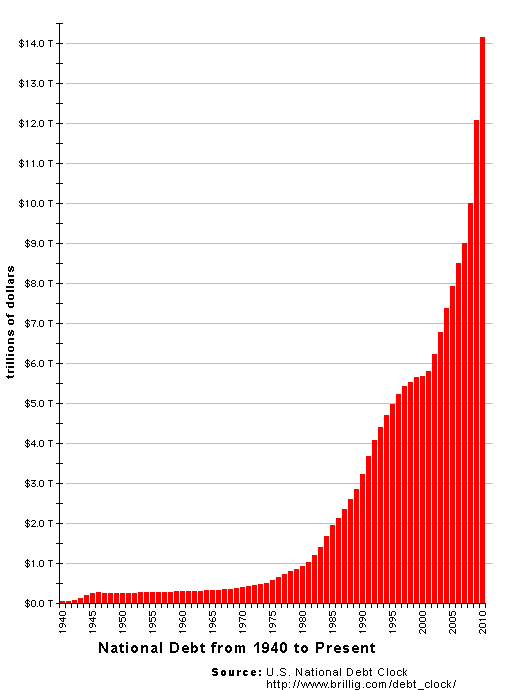 Most Americans have a deep aversion to the phrase “redistribution of wealth”, and rightly so. On a fundamental level, it is just not right to take the money that one man has worked so hard to earn and “redistribute” it to someone else. In the political realm, the phrase “a redistribution of wealth” is usually a reference to our ballooning social programs, but what most Americans don’t realize is that one of the biggest redistributions of wealth in world history took place during the Wall Street bailouts of a couple years ago. Trillions of dollars of our money and of money that belongs to future generations was redistributed to the Wall Street bankers. The Wall Street bankers did not earn this money and they did not deserve this money. We were told that if Wall Street did not get this money that the global economy would collapse and that there would be martial law in the streets. We were promised that this money would “fix” Wall Street and then the prosperity would “trickle down” to Main Street. So did this happen? Of course not.
Most Americans have a deep aversion to the phrase “redistribution of wealth”, and rightly so. On a fundamental level, it is just not right to take the money that one man has worked so hard to earn and “redistribute” it to someone else. In the political realm, the phrase “a redistribution of wealth” is usually a reference to our ballooning social programs, but what most Americans don’t realize is that one of the biggest redistributions of wealth in world history took place during the Wall Street bailouts of a couple years ago. Trillions of dollars of our money and of money that belongs to future generations was redistributed to the Wall Street bankers. The Wall Street bankers did not earn this money and they did not deserve this money. We were told that if Wall Street did not get this money that the global economy would collapse and that there would be martial law in the streets. We were promised that this money would “fix” Wall Street and then the prosperity would “trickle down” to Main Street. So did this happen? Of course not.
What ended up happening is that Wall Street hoarded all of this cash. Lending to individuals and small businesses actually decreased. The Federal Reserve started handing out gigantic piles of nearly interest-free money which many of these big Wall Street banks immediately loaned back to the U.S. government at a significantly higher rate of interest.
Talk about easy money.
Now the big Wall Street banks and the ultra-wealthy are swimming in cash and sales of luxury goods in the United States are absolutely skyrocketing. Meanwhile, millions of “ordinary” Americans continue to slip into poverty.
So is the answer to all of this just to “tax the rich” and redistribute the wealth again by giving more handouts to the poor?
Of course not.
The American people don’t need more handouts.
What the American people desperately need are some good jobs.
But Wall Street is hoarding the cash they got during the bailouts.
It would be one thing if these big Wall Street banks had made a ton of money based on their own efforts. It is a very American thing to be able to enjoy the fruits of hard work.
However, the truth is that many big Wall Street banks and financial institutions may have completely imploded if not for the bailouts.
They were “too big to fail” and our politicians jumped to their service.
Our politicians redistributed wealth by taking trillions of dollars that belonged to us and to future generations and handed it to the folks on Wall Street.
So now the boys and girls over on Wall Street are thriving while tens of millions of “average” Americans are desperately suffering.
Does that seem right to you?
Isn’t it about time that the U.S. government gets out of the “redistribution of wealth” business altogether?
Just consider the following statistics. Even as the economic suffering of ordinary Americans continues to deepen, those who got big piles of bailout money are living the high life….
#1 According to Stephen Lewis of Monument Securities, luxury retailers in the United States have seen an 8.1 percent increase in sales compared to a year ago, while “discount stores” that cater to the poor and the middle class have only seen a 1.2 percent increase in sales compared to a year ago.
#2 The sad truth is that just about every company that deals in luxury goods is booming, while those that primarily serve ordinary Americans are not doing nearly as well. Just consider the following quote from a recent article by Ambrose Evans-Pritchard of the Telegraph….
Tiffany’s, Nordstrom, and Saks Fifth Avenue are booming. Sales of Cadillac cars have jumped 35pc, while Porsche’s US sales are up 29pc.
Cartier and Louis Vuitton have helped boost the luxury goods stock index by almost 50pc since October. Yet Best Buy, Target, and Walmart have languished.
#3 Elderly Americans in particular are really having a hard time of it right now. A recent study by a law professor from the University of Michigan found that Americans that are 55 years of age or older now account for 20 percent of all bankruptcies in the United States. Back in 2001, they only accounted for 12 percent of all bankruptcies.
#4 The number of Americans on food stamps has hit another all-time record. There are now 43.2 million Americans enrolled in the food stamp program.
#5 According to the U.S. Conference of Mayors, visits to soup kitchens are up 24 percent over the past year.
#6 Meanwhile, the price of food continues to go up. This hits poor and middle class Americans much harder than it hits the wealthy. According to a report on 55 top food commodities by the Food and Agriculture Organization, global food prices reached a new record high during December.
#7 Lester Brown, the president of the Washington-based Earth Policy Institute, is publicly declaring that the world is just “one poor harvest” away from total chaos….
“The reality is that the world is only one poor harvest away from chaos. We are so close to the edge that politically destabilizing food prices could come at any time.”
#8 The price of clothes is also increasing dramatically. It turns out that cotton is 80% more expensive now than it was back at the beginning of 2010.
#9 Americans will also be paying more at the gas pump this upcoming year. In fact, former Shell Oil President John Hofmeister recently stated that Americans could be paying 5 dollars for a gallon of gasoline by the end of this upcoming year.
#10 Health insurance rates are also skyrocketing. Blue Shield of California recently announced plans to raise health insurance rates by an average of 30% to 35% this year, and some individual policy holders could actually see their health insurance premiums rise by a whopping 59 percent.
#11 On top of everything else, the U.S. Census is now telling us that there are millions more poor people in America than they had previously calculated. The U.S. Census Bureau recently revealed that the figure of 43.6 million Americans living in poverty that they announced last September was way too low and that actually 47.8 million Americans are now living in poverty.
#12 If all of these economic problems were not bad enough, now many state and local governments are seriously considering raising taxes. In Illinois, there is now a proposal to raise state income tax rates by 75 percent. A recent article that appeared on the CNBC website explained why Illinois is so desperate for cash….
In a moment when states around the country are wrestling with withered revenues, Illinois faces a deficit of at least $13 billion; more than $6 billion in unpaid bills to social service agencies, schools and funeral homes; the most underfinanced state pension system; and growing signs of concern from bond investors.
So won’t the big Wall Street banks and the ultra-wealthy get hit by these tax increases too?
Some of them will, but many of them have learned to “play the game” so well that they barely pay any taxes at all.
As I have written about previously, a third of all the wealth in the world is now held in offshore banks. When taxes go up, the ultra-wealthy are not the ones that have their wealth “redistributed”. Instead, it is poor saps like you and I that have our wealth “redistributed”.
In fact, the next time another “financial crisis” comes along, the financial “powers that be” will once again come running to Congress and come running to the Federal Reserve begging for more bailouts.
Now that the precedent has been set, it will only seem natural to redistribute even more of our wealth to the folks over on Wall Street so that we can “save” the financial system.
But the truth is that our financial system is completely doomed to fail in the long run and throwing our money into the financial system is like throwing our money into a black hole.
In the end, all of us are going to greatly suffer when the financial system finally crashes. But for the moment the wealthy are partying with all of the money that they have looted from the rest of America, and the rest of us which were “small enough to fail” have been left to scratch and claw and fight with each other as we desperately try to survive in this horrible economy.







